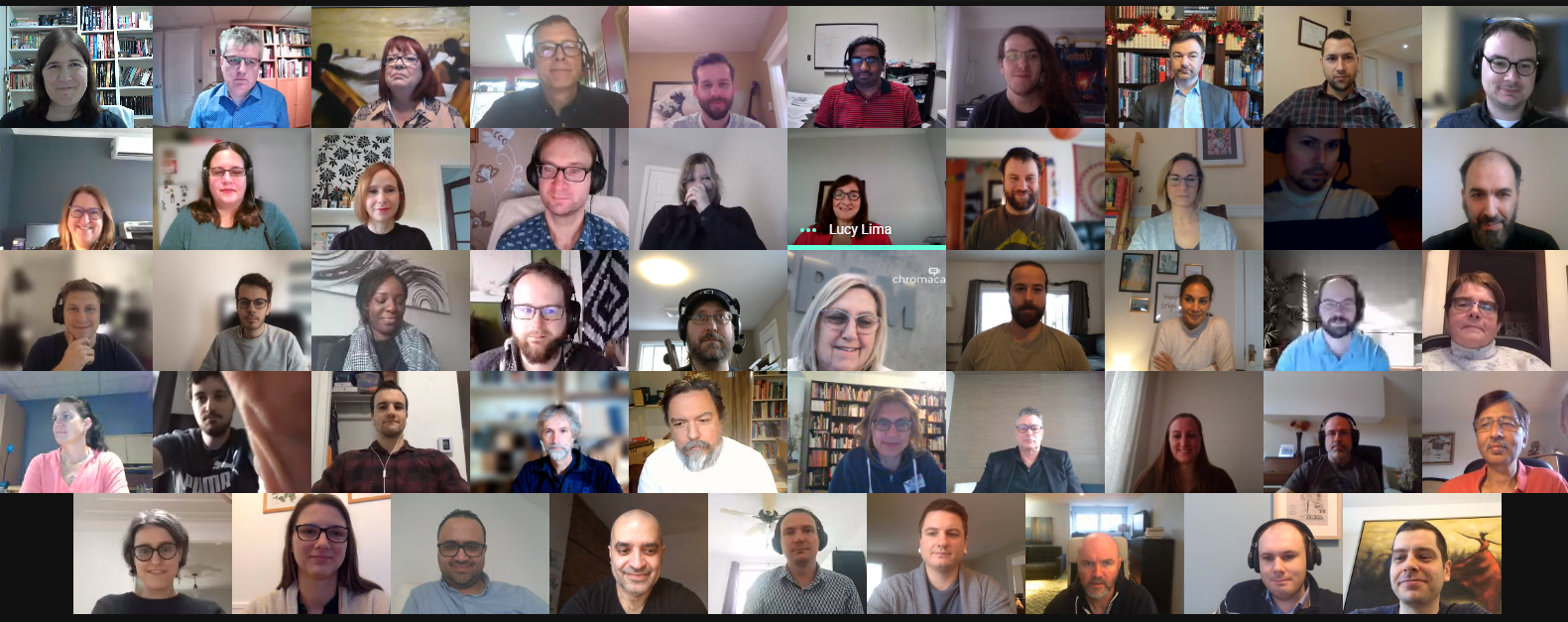A Bit of History
The year is 1985: Research institutions were working in silos, and scientific research was their safeguard. A group of academics and entrepreneurs believed that by bridging the gap between academia and business, Québec could become a competitive and innovative economy. The Computer Research Institute of Montréal (CRIM) was born, a place where professionals from various disciplines joined forces to work on advancing science. To foster the sharing of work and resources in the field of artificial intelligence (AI), CRIM set up one of the very first computer networks in 1989: the Québec Scientific InterComputer Network (RISQ), which connected universities, research and computing centers. In the 1990s, this network expanded to include companies from all sectors.
In retrospect, CRIM laid the foundations of the artificial intelligence ecosystem as we know it today.

AI as a Multidisciplinary Approach: CRIM’s Differential Advantage
CRIM is home to a critical mass of multidisciplinary experts who apply the components of artificial intelligence to diverse types of data: speech, audio, text, images, video, and structured data.
Just a Quick Note:
InnovationsOfTheWorld.com has partnered with Trade License Zone (TLZ) to support global innovators looking to expand internationally. Take advantage of the UAE’s Free Zones—enjoy streamlined setup, low corporate taxes, and a strategic gateway to the Middle East and beyond.
Get Your UAE Free Zone License Fast & Easy!Working in multidisciplinary mode paves the way to innovative AI solutions at a global scale. To illustrate:
• Closed captioning (CC) combining speech and text recognition: the original project dates back to 2001, when Locus Dialogue, Groupe TVA and CRIM joined forces to develop high-quality CC technology in real time for the hearing impaired.
In 2005, they were able to offer hearingimpaired sports fans live captioned hockey games broadcast by the Réseau des sports (RDS).
After a decade of outstanding results with over 15,000 hours a year of live CC content, SOVO Technologies was born – a CRIM spin-off company – and continues to expand internationally.
• An intelligent tutorial for emergency calls triage, as well as tools for recognizing stress in first responders through facial expressions and a tool for predicting response time to alerts developed for the Montréal Fire Department (winner of an OCTAS award in 2019).
• Heritage conservation: in 2018, CRIM, the National Research Council Canada, the Pirurvik Centre and the Canadian Broadcasting Corporation (CBC) came together to support the revitalization and protection of Indigenous languages through speech and text technologies.
• An algorithm combining expertise in image analysis and data science that detects street furniture in cities and municipalities, developed for Jakarto, a high-definition mapping company.
• Applications that monitor ice evolution and that assess forest biomass, as well as Machine Learning techniques to infer soil textures in order to optimize the use of fertilizers.

Businesses and CRIM: A Solid Partnership
Over the years, thousands of Québec companies have benefited from CRIM’s collaborative approach leading to knowledge and technology transfers that add value. To its clients and community, CRIM conveys this message: what makes artificial intelligence work is a combination of expertise. There needs to be expertise not only in algorithms, but in software and data as well.
Today, CRIM can pride itself on having successfully developed AI solutions in multiple industries: automobile, insurance, entertainment, environment, healthcare, etc. As a result, several industry prizes were awarded to organisations having sought CRIM’s AI expertise.
• 1993: OCTAS award for the Pitch Expert solution; recognized as one of top 16 AI applications in the world, by the American Association of Artificial Intelligence (AAAI)
• 2019: OCTAS award – category City and Public Organization, for predictive modelling applied to operations at the Montréal Fire Department (SIM)
• 2020 : ADRIQ Innovation Award – category Partnership – voted Public Favourite, for UEAT intelligent meal recommendation application

Outstanding Men and Women
CRIM earned respect from its peers and the Québec ecosystem as a whole for the quality of its researchers and professionals, as well as its openness to the world. Men and women have come to CRIM to develop their AI knowledge and skills, and have gone on to become established professionals, respected managers, internationally renowned researchers, entrepreneurs competing with major industry players, and even the CEO of ÉTS (École de technologie supérieure), Montréal’s renowned engineering faculty.
In addition to some 60 employees, CRIM welcomes students to work with our experts and to further their academic knowledge, as well as interns from prestigious universities around the world.

AI Platforms for All
Many AI platforms, tools and algorithms developed by CRIM are made available to other scientists to accelerate discovery. Examples include VESTA for the creation of complex annotations on audio and video files, in the social sciences; PACTE, a bilingual web platform for collaborative annotation of text content, which reduces annotation time while facilitating data analysis; or the Big Data tool PAVICS and the ClimateData.ca portal for decision makers in all things related to climate.

International Competitions and Conferences
CRIM distinguishes itself within the scientific community by participating in numerous international competitions where it consistently ranks among the top recipients. These include the National Institute of Standards and Technology’s competitions, such as the TRECVID video copy detection challenge in 2009. These competitions allow researchers to push the limits of technology and learn together in accelerated mode.
It also boasts a list of more than 500 scientific publications since 2000, the majority of which focusses on AI.

In addition to its publications, CRIM organizes and supports major conferences. These include the Boule de cristal series with its many prestigious guests, including Apple co founder Steve Wozniak in 2007; the 9th Journée francophone pour l’intelligence artificielle et les systèmes multi agents in 2001; the most prestigious international AI conference, the International Joint Conference on Artificial Intelligence in 1995; and lastly, the 6th AI Symposium organised in the CRIM’s first years.

CRIM is also a socially committed organization that has the future of the planet at heart. The 5th edition of the Boule de cristal, in 2008, addressed environmental issues with special guest environmentalist David Suzuki. The following years were emblematic of this meeting, as a series of environmental projects unfolded and CRIM experts began to contribute to the development of global standards for geospatial data.
The Québec ecosystem continues to reassert its confidence in CRIM, one of Québec’s most resilient institutions. And as a leader in Artificial Intelligence, CRIM will continue providing a vision into the future of technologies. In the post-pandemic world, its role will be key to driving innovation and economic growth.
Did you know? In 2010, CRIM was the first organization to set up shop in the AI district, now known as Mile-Ex, an innovation hub with multiple partners.

Principal partenaire financier














